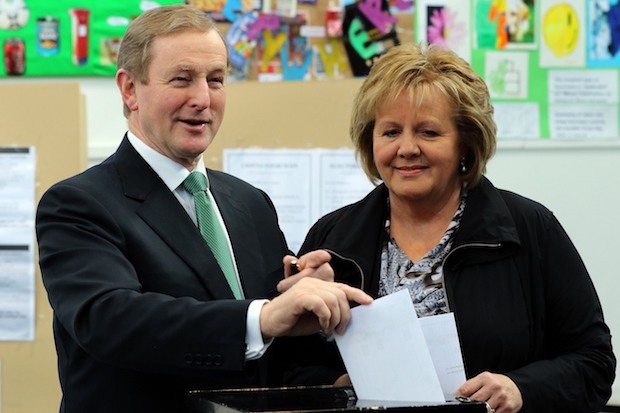Dublin
Ireland goes to the polls today. The Google Doodle is up, the shadow of history hovers with the 1916 centenary—and Ireland, caught between the two, stalls halfway through a political software update to becoming ‘Ireland Centenary Edition’.
Elections are heady things in Ireland these days, on the heels of last year’s Marriage Referendum which saw millennials and returning emigrants registering to vote in droves. Turnout reached 61 per cent last May. In the 2012 and 2013 referenda, it had been 33 and 39 respectively.
Ireland, the headquarters of Google and Facebook, has started to morph from the Charles Haughey-era politics of ‘Down with this Kind of Thing’ to a Hashtag Ireland, with #HomeToVote and #MarRef trending. But it’s happening imperfectly.
Irish politics remains dominated by a split based not on ideology, but on which side of the 1922-23 Civil War your great-grandparents fell on. If they were with Collins then, that makes you Fine Gael now. If De Valera, it’s Fianna Fáil for you. Both Fianna Fáil and Fine Gael span social democrat and Christian democrat wings. Ireland’s Civil War parties are both grand coalitions.
Britain’s Prime Minister—who benefited in Brussels from political cover from a likeminded Enda Kenny—has unusually written to Ireland’s Taoiseach with a handwritten ‘Good luck!’ Both have staked claims to re-election on records of economic recovery through government belt-tightening and austerity.
But the signs—and this is treacherous territory after the last Westminster election—are that in Ireland’s 32nd election, the governing Fine Gael-Labour coalition will struggle to reach the magic number of 79 members. A surge of independents and fledgling new parties eking out corners of the ideological spectrum—Social Democrats on the left, Renua on the right—show the way towards Ireland’s next politics. But we are not there yet.
In a less modern direction, Sinn Féin’s anti-austerity politics of discontent has hoovered up as much as 21 per cent of support, performing shockingly well against a Fine Gael that has bounced from 26 to 31. Fianna Fáil has reaped between 17 and 22 per cent.
The back of every envelope around Dublin’s Leinster House today is covered with different ways the maths might work, all of them peculiar. ‘Fianna Gael’ is one answer to the sums, a grand coalition of the historic alternating rivals. It has not happened here before.
A perceptive source of opposition has come from Leo Varadkar— the coalition’s brainiest and most visible member. Ireland 2.0’s politician par excellence, he is 37, a doctor with Irish and Indian parents and Ireland’s first openly gay minister.
Fianna Gael, says Varadkar, is a gift to Gerry, letting Sinn Féin ‘become the main opposition, which is where it really wants to be.’
The governing coalition will hope to finish the day in near enough striking distance that a few independents will push it over the line. (Ireland has form here—feisty independents like Jackie Healy-Rae in Kerry South, who from 1997 to 2011 sold external support to Fianna Fáil for local roads and schools in every vote.)
But a few take-away points emerge from this close-fought political scrapfight:
Gerry Adams was much more impressive when we couldn’t hear him. Not for the first time, Sinn Féin’s message of discontent found an audience early in the campaign—but Gerry Adams and deputy leader Mary Lou McDonald struggled to keep it from slipping towards more established parties with election day focussing minds.
Beware the Clegg Syndrome. The smaller, more socially liberal junior coalition partner gets a disproportionate hammering in the polls, which is spared the larger partner—sound familiar? Except this time it’s Joan Burton, head of the Labour Party, according to polls on track to lose her own seat in Dublin West.
Burton pitched Labour’s message towards a plebiscite on general policy continuity, abandoning its core breadwinning constituency on the centre-left. As a result, the key battles were waged in this contestable space created by Labour’s departure.
Sometimes campaigning works. Fianna Fáil, blamed for the bank crisis and frozen out from the last elections, picked up 4 per cent on the doorstep. One of Ireland’s strongest parliamentary debaters, Micheál Martin came out on form in debates, and skilled new talent like Michael McGarth as finance spokesman performed well against Fine Gael’s star Leo Varadkar. It didn’t manage to deliver tangible ideas, but with Labour leaving it significant room to recover its electoral fortunes, it provided plenty of well-pitched oppositional rhetoric, re-inventing itself as the new party of the centre-left.
The Indies Rock. No matter how strong their showing in the current election is going to be, they and other new political groupings emerging on both the left and right in this election are offering, says Irish economist Dr Constantin Gurdgiev, ‘something missing in Irish politics—integrity, honesty, openness and debates’. The current coalition have not connected with public appetite for renewal and reforms in the political system—the lingering sense of Irish politics as a ‘palace of parochialism, corruption, and cronyism,’ says Dr Gurdgiev.
But neither have Fianna Fáil, or Sinn Féin, which disinterestedly has been calling for the dis-establishment of the Special Criminal Court, just after it found former IRA army council head Thomas ‘Slab’ Murphy guilty of nine counts of tax evasion.
It’s not as heady stuff as last May’s marriage referendum, and it will be messy, but there are signs that a hundred years after Easter 1916, Irish politics may start downloading a needed centenary edition update.






Comments